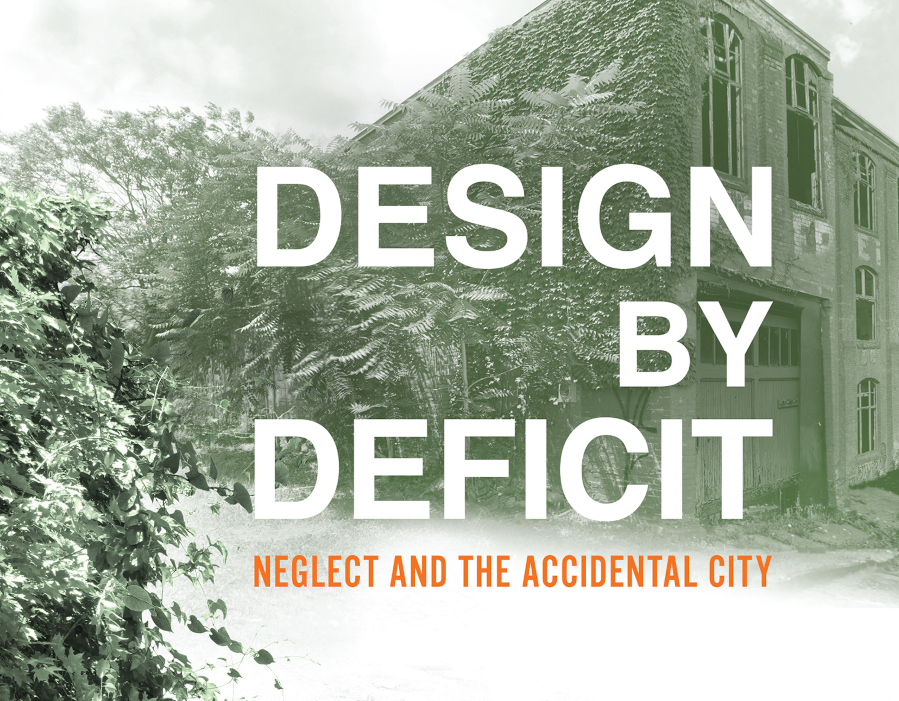Design by Deficit: Neglect and the Accidental City
Lucy Campbell and Barbara Opar, column editors
Column by Susan Dieterlen, RLA PhD, Founder, DeftSpace Lab, Woodbridge, Connecticut.
Design by Deficit and Studio|Next: Twin Progeny of the Neglected, Transforming City
How do cities confront neglect in urban environments while navigating climate change, inequality, and the pandemic? The decade I’ve spent studying this topic has produced a family of products, spanning teaching, research, and design. My recent book, Design by Deficit: Neglect and the Accidental City, sprang from this line, as did my 2016 course “Studio|Next: Building the Post-Carbon City.” Parallel products like these inform each other and improve both projects.
Design by Deficit: Neglect and the Accidental City
Design by Deficit explores how everything we don’t do – what falls off our to-do lists – shapes cities. Since our lives interact with our surroundings, these unintended consequences shape our lives, too. This neglect can be the primary designer of urban environments, and we never even notice it.
Design by Deficit reveals neglect’s impacts, including accidental urban nature, crumbling infrastructure, and abandoned spaces beyond rules. Neglect also has some surprising benefits. There’s crime and fear, but there’s also stress relief and life-sustaining ecology. The city’s “shadow” – neglect – benefits some of us, some of the time, even out in the suburbs.
As a longstanding trend already positioned in critical locations, neglect can be an ally against climate change, inequality, and public health crises. Design by Deficit considers who will benefit and how to balance costs, using a tactical approach that puts neglect to work for us. This is a conversational, informal book for officials, professionals, and students doing hands-on work in policy, planning, and programming.
Studio|Next: Building the Post-Carbon City
In the spring of 2016, I developed and taught “Studio|Next: Building the Post-Carbon City” to upper-level undergrads and graduate students in Syracuse University’s School of Architecture. “Studio|Next” applied design thinking to the postindustrial city negotiating the complex challenges of climate change, failing infrastructure, and the need for technological innovation, or “heat/neglect/data.” These major issues will loom large in careers just beginning today.
We developed thoughtful yet feasible urban designs deeply rooted in analysis of city-wide systems and challenges, proposing small designs resting on big ideas. The studio featured “Disintegration,” bus stop designs resisting and enlisting entropic processes, such as erosion, corrosion, and vandalism. As the Flint drinking water crisis unfolded, students investigated failing urban systems in the second project, “System Fail,” selecting sites and proposing tactical designs to mitigate the system’s failure and improve its function.
Our main project, “Energy in the Landscape,” identified opportunities for distributed clean energy generation and use within central Syracuse, then proposed structures and sitework on small sites, addressing energy goals in a realistic, sometimes temporary fashion. Our work dovetailed with the state’s “Reforming the Energy Vision (REV)” plan, with guest speakers showcasing the rollout of the REV and ongoing industry research. Students shared their works in progress with energy professionals and working designers. This bridging of divides – theory to built work, socioeconomic to ecological concerns, profession to profession – was integral to the studio. The situating of projects within Syracuse was key as well, allowing students the opportunity to layer their designs and system analyses throughout the semester.
Books and studios, studios and books
There’s no better place to take a book idea or a research topic for a walk than in the classroom. The unfettered creativity of studios is jet fuel for idea development. Research is a black box to professional degree students. Book writing is a black box to virtually everyone who hasn’t done it. Students in a course like this have a front row seat as these mysterious processes happen, while the instructor-author gets the gift of a fresh audience full of enthusiasm following her work. I cannot overstate the value of that to continuing the long, lonely slog of writing and publishing a book. Classes provide invaluable feedback on not just subject matter, but on language and voice.
A studio like this one, featuring local government officials, energy professionals, and working designers against the backdrop of the real-life development of the state’s clean energy strategy, keeps a research project grounded in practicality. This makes for a satisfyingly substantial studio (and good future contacts for the students), but also keeps the instructor-author from wandering too far into the weeds with her book manuscript. It also helps build in a wider audience for the published book, an overriding concern in this era of upheaval in publishing.
As creative people, designers can find writing to be terribly restrictive. Books are about something, not everything. Especially in non-fiction that is neither history nor memoir, a primary challenge is finding a narrative to organize the material. Studios, in contrast, are freewheeling and creative at their core. They engage many minds and run in every direction at once. You refine and clarify your own thoughts about your topic as you discuss and critique students’ projects. The two products, studio and book, complement and balance each other, one outward energy, one inward focus, both driving toward the same goal.
Questions
Heather Albarazi
Digital Marketing and Communications Manager
202-785-2324 Ext.5
halbarazi@acsa-arch.org

 Study Architecture
Study Architecture  ProPEL
ProPEL 
